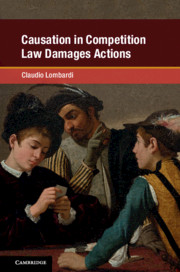Book contents
- Causation in Competition Law Damages Actions
- Global Competition Law and Economics Policy
- Causation in Competition Law Damages Actions
- Copyright page
- Dedication
- Contents
- Acknowledgements
- Table of Cases
- Introduction
- 1 Causation in Competition Law
- 2 Causation Rules in National Courts
- 3 Causation in the European Union Competition Law and Decisions
- 4 Causal Uncertainty in Competition Law Damages Claims
- 5 Proof Rules of Causation
- 6 Proving the Uncertain Causation
- 7 Causation in Indirect and Secondary Antitrust Damages
- Conclusion
- Bibliography
- Index
7 - Causation in Indirect and Secondary Antitrust Damages
Published online by Cambridge University Press: 03 December 2019
- Causation in Competition Law Damages Actions
- Global Competition Law and Economics Policy
- Causation in Competition Law Damages Actions
- Copyright page
- Dedication
- Contents
- Acknowledgements
- Table of Cases
- Introduction
- 1 Causation in Competition Law
- 2 Causation Rules in National Courts
- 3 Causation in the European Union Competition Law and Decisions
- 4 Causal Uncertainty in Competition Law Damages Claims
- 5 Proof Rules of Causation
- 6 Proving the Uncertain Causation
- 7 Causation in Indirect and Secondary Antitrust Damages
- Conclusion
- Bibliography
- Index
Summary
A competition law infringement is capable of damaging different subjects at the same time, virtually all the market players that are directly or even indirectly connected with the business of the competition law infringer. Economic activities are indeed structured on value chains, which are interconnected networks of contracts and hierarchies operating in a market. Here, the action or decision of a market player may impact many of the other market participants, affecting both their future strategies and their actual assets. For instance, the abuse of a dominant position causing the foreclosure of a competitor may equally impact on the business partners of that competitor and on its employees, as well as on the consumers of both markets. We will call ‘indirect economic losses’ all those damages that are a consequence of an infliction of damage upon a third party. When the harm is inflicted upon a third person which in turn causes harm to the claimant, we will instead refer to it as ‘secondary harms’.
Keywords
- Type
- Chapter
- Information
- Causation in Competition Law Damages Actions , pp. 164 - 191Publisher: Cambridge University PressPrint publication year: 2020

